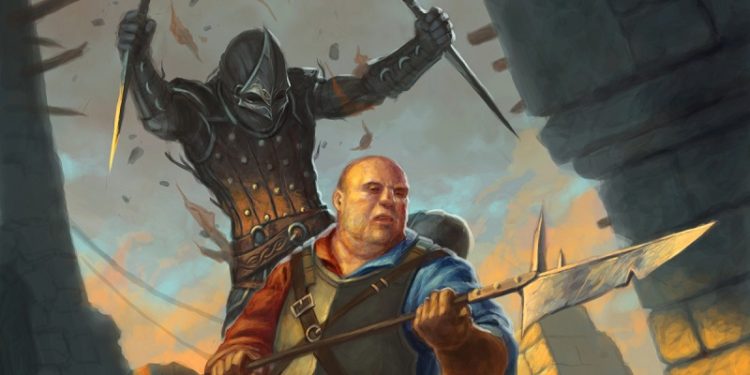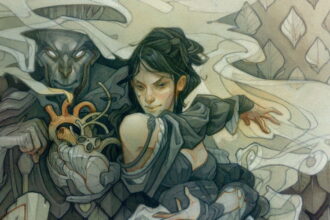D&D 5e – Using More Passive Checks

Lately, I have been focusing my campaign on using more passive perception and passive investigation so there aren’t as many die rolls. I’ve stopped asking for so many skill checks, and instead rely on a listing of the character’s ability scores & skills to make determination of success or failure. And this helps in describing the environment to the players, because I can instantly decide to give more information based on their character’s information.
So we get Passive Skill checks from D&D 4th edition. It is a useful tool for the DM to add to descriptions and help make the game a little faster. The Passive Skill allows for a floor for things like Perception and Investigation. The party of characters go into a situation, and their passive scores dictate their initial scene. If one of them decides to actively search or investigate, then their skill roll would only “matter” and add to the description if the result is higher than their passive score.
So now, only when a character attempts an action that might fail, I’ll ask them make an ability or skill check. If they get a higher result than their passive score (rolling on the die higher than 10), then I can give them more information or succeed at the task. But remember, the trigger for the die roll is a player telling the Dungeon Master that they are performing a specific action that might fail. You might have a player that takes an action with a skill so that they can roll, but if you get in the habit of describing and using passive checks, they might stop making so many rolls.
PASSIVE CHECKS
A passive check is a special kind of ability check that doesn’t involve any die rolls. Such a check can represent the average result for a task done repeatedly, such as searching for secret doors over and over again, or can be used when the DM wants to secretly determine whether the characters succeed at something without rolling dice, such as noticing a hidden monster.Here’s how to determine a character’s total for a passive check:
10 + all modifiers that normally apply to the check
If the character has advantage on the check, add 5. For disadvantage, subtract 5. The game refers to a passive check total as a score.For example, if a 1st-level character has a Wisdom of 15 and proficiency in Perception, he or she has a passive Wisdom (Perception) score of 14.
~ Player’s Handbook Page 175
A typical example of using Passive Perception is seeing a creature that is hidden in a room:
We have a Goblin that has hidden in the darkness of a room that the characters have entered. The 11th Level Party consists of a Human Cleric, Halfling Rogue, Half-Orc Fighter & Elf Wizard. The characters have passive perception scores of 15, 20, 9, 12 respectively.
The Goblin has made a Dexterity (Stealth) check of 18, and is hiding in a part of the room with dim light. I have all of the character’s passive perception scores, and I note that each character without darkvision gets a -5 from their passive perception to notice the Goblin [PHB 183]. This results in passive perceptions scores of 10, 15, 9 & 12 (same order as above). I can quickly look down at a sheet, and know if the characters spot the Goblin with out anyone rolling a die. I describe the room in enough detail to satisfy the passive ability scores. Whichever character has the highest passive check (The Rogue), I will let them know they see a little bit more details than what I gave out to the other players. But the goblin just stays hidden because all of the character’s passive scores fall below 18 with the highest Passive Perception against the hiding Goblin is a 15 for the Rogue [PHB 177].
A character may take an Action to attempt a higher score than their passive. And if they get 18 or higher, then they will see the Goblin. So the Rogue decides to search the room and check the dark areas [PHB 178], and will roll at disadvantage because of the lightly obscured areas (dim light) [PHB 183]. Without specifically saying they are searching the dark areas, the goblin would stay hidden. The action of searching has to be specific in order to determine the chance of success, and not a generalized “I search the room.” because that was already done with their passive perception. The Rogue rolls a 7 and 15, and that result of 7 is brought up to a 10 because of Reliable Talent [PHB 96]. The Rogue spots the hiding Goblin in the dim lighted area with a result of 20 on his Wisdom (Perception) check.
We have an example of Passive Perception skill, but there are other ways that I can use the characters ability & skill scores to allow more passive checks. Below are some examples, not all of these skill have explicitly follow their Ability score counterparts (see Variant: Skills with Different Abilities PHB page 175), but these are just typical:
Strength
- Athletics – The Wizard finds that the door is stuck, and is denied because it has a DC 15 (their passive is 9). The Wizard could try to force it open, and that would call for a skill check (d20 + modifiers) . The Barbarian walks over and with their high Passive Strength (Athletics) of 20 easily forces the door open.
Dexterity
- Acrobatics – The door opens, but the room has no floor, but a single 6″ wide board running across a large pit with spikes. A difficult traverse, but the Rogue decides to walk across and does so easily with such a high passive score. The Fighter doesn’t risk it and waits for the Rogue to return.
- Sleight of Hand – The Rogue finds a Golden Statue under a large weighted spring trap. He easily snatches the statue as the trap smashes down without crushing & trapping the Rogue’s hand.
- Stealth – This is one that I normally use for NPCs and Monsters. They are hidden, so I use their passive score.
Intelligence
- Arcana – The Wizard finds a Red leather book in a store that has familiar sigils. He knows that it belongs to a Magic School that can be found on the Mafic Road in the City of Atla
- History – We have a Cleric that recalls a great battle that took place at this site and defeated an Orc Leader. But can’t recall his name, the Wizard has a higher passive, and remembers that it was Azhurg the Brittle.
- Investigation – A Rouge walks past a bookshelf, and from the markings on the floor, deduces that the bookshelf doubles as a secret door that pulls out into the room.
- Nature – The party notices some strange purple mushrooms on the forest floor. The Druid knows that these are dangerous and can induce poisoning by touching them with your bare hands.
- Religion – A Warlock walks into a temple, but doesn’t touch the forehead of the statue on the right. The priest in the temple are now suspicious.
Wisdom
- Animal Handling – The Barbarian sees a lone wolf approaching. He can tell from it’s walk, that it is hunting, and definitely a lead for a hunting pack.
- Insight – The Paladin just knows that guy is lying to the adventuring party. The innkeeper is not sincere when he tells you that the western road is safe and free of trouble.
- Medicine – Looking at the unconscious human, the Cleric knows from the rapid breathing and beading sweat on their forehead that he has been poisoned somehow. Rolling him over there is a small knife wound surrounded with a trace of a black sticky substance.
- Perception – Standing in the crowd, you notice a suspicious dark hooded figure out of the corner of your eye that dashes behind a corner into the alley.
- Granger 44: “Something is odd about the performer’s rendition of this soliloquy. You notice the performer mouthing things during the dramatic pauses, almost as if he’s trying to communicate with someone…another performer or an audience member perhaps?“
- Survival – Our Druid was able spot the tracks that a horse left that lead off the main road into some brush to a side trail.
Charisma
- Deception – The Wizard talks walks over to the barkeep to let him know the stables are on fire. (They aren’t)
- Intimidation – The Fighter walks over to the bar. The barkeep stammers, “Whwhwhhhat will you have mister?”
- Performance – This is a difficult one, as it is mostly an active ability of performing. Maybe you have an idea of how this can be a passive skill?
- Granger 44: “You notice the performer limps during his stage walk as Horatio, but do not recall that being in the script nor does it seem indicative of a style. You suspect the limp is not an act, but an actual injury.”
- Persuasion – I use this as basis on how NPCs initially react when greeting & talking to the characters. The Bard walks over and the barkeep’s face lights up and smiles. The Wizard then walks over, the barkeeps ignores him and starts talking to another customer.
These are all just examples, and I am sure there are others that might be better than the ones I put together. Please let me know what you think. and I can always add to these ideas.
Thanks!
LINKS
https://media.wizards.com/2016/downloads/DND/PH-Errata-V1.pdf
EDIT: added some clarifications and additions that you’ve suggested. 🙂



